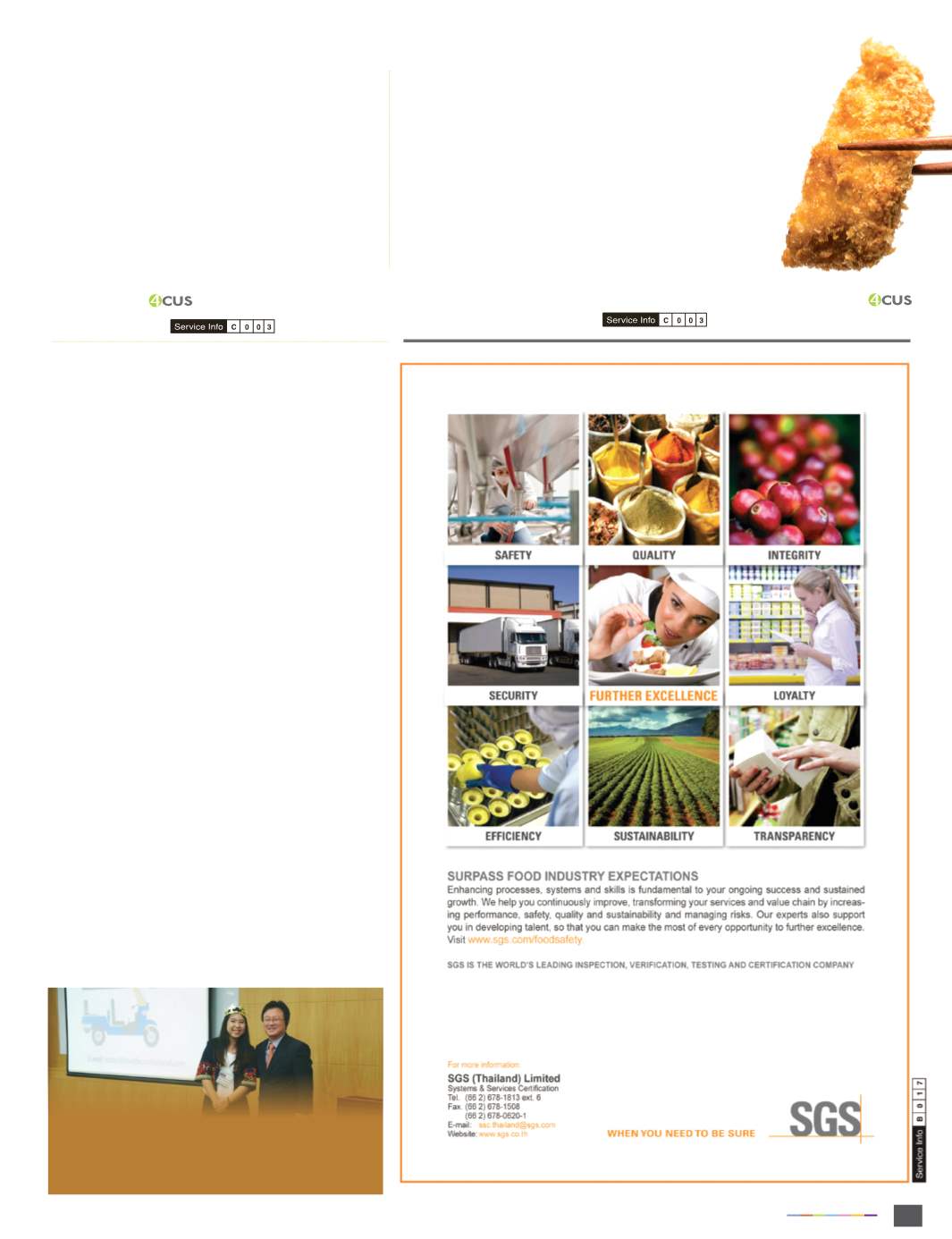
Food FocusThailand
DECEMBER 2015
37
The two Korean foods registered as UNESCO’s world
heritage are Kimchi and Bibimbap. With an increasing trend
toward slow food, in a span of only 1 year, slow foodmenus
have rapidly expanded from32 to 50.
• Professor ParkTae-gyoun
GraduateSchool of Food andDrugAdministration
of Chung-AngUniversity
FoodandDrugColumnist
TheRoyalCourtcuisine, regardedas thecountry’sCrystal
of traditional foodculture, served insetsonaspecial table for
the King, is called Soora Sang. It is presented with 12 side
dishes of various selections e.g. vegetables and salted
seafood, 5 times aday (small meals). Five characters of The
Royal Court cuisines are:
• Variety in raw-material selections andpreparations
•Madewith nice looking vegetables and fish
• Presenting true tastes of ingredients
•Meticulously and carefully cooked
• Good for theKing’s health
Temple foodsarestrictlyvegetarian, inwhich5vegetables
are prohibited: green onions, garlic, leek, wild chive and
Chinese squill, for they are believed to cause sexual desire.
The use of white rice is also banned for it is said to be of no
nutritionalvalue.Threemaincharacteristicsof the temple foods
areminimal amount,minimal sidedishandminimal ingredient
with only tree ingredients present: lotus root (representing
Buddhism), Koboor Burdock roots andherbs or plants in the
Butterbur family.
Family’s foods (Jong Ga) are the foods whose recipes
were inherited within the family by wives of the eldest sons.
Generally viewed by the younger generations as too
complicated, and unappetizing with too many side dishes,
family’s foods have been continuously modified to suit the
modern tastes with fewer side dishes, towards the famous
Slow food trendof today.
However,SouthKoreastilldoesnothaveasinglecommon
culinary policy and, through this and future conferences, it is
hoped to form a cooperation amongst Asian countries, e.g.
China,JapanandThailand, toestablishnetworksofacademics
andmassmedia personnel in the field of culinary.
มุ
มมองภาพรวม
การเผยแพร่
วั
ฒนธรรมอาหารมี
ความจ�
ำเป็
นอย่
างมากอาหารของแต่
ละ
ประเทศมี
เอกลั
กษณ์
พิ
เศษ จึ
งควรมี
ความภาคภู
มิ
ใจในอาหารของชาติ
เราเอง และควรรั
กษาความภาคภู
มิ
ใจนี้
ประเทศในแถบตะวั
นตกไม่
ได้
มี
วั
ฒนธรรมที่
ยาวนานไปกว่
าแถบเอเชี
ยแต่
มี
การศึ
กษาวิ
จั
ยด้
านอาหาร
มายาวนาน ประเทศในภาคพื้
นเอเชี
ยควรร่
วมมื
อกั
นเพื่
อเผยแพร่
ประชาสั
มพั
นธ์
อาหารเอเชี
ยซึ
่
งมี
จุ
ดแข็
งในด้
านอาหารสุ
ขภาพให้
เป็
น
ที่
รู
้
จั
กทั้
งในระดั
บประเทศและนานาชาติ
เพื่
ออนุ
รั
กษ์
มรดกทางวั
ฒนธรรม
ให้
สื
บทอดสู
่
รุ
่
นลู
กรุ
่
นหลานต่
อไป ในขณะเดี
ยวกั
นปั
ญหาที่
เกิ
ดขึ้
น
จากอาหาร เช่
น ภาวะทุ
พโภชนาการ ก็
ควรร่
วมมื
อกั
นเพื่
อหาแนวทาง
ในการแก้
ไขปั
ญหา
Special Thanks
The conference on “Forum between 4 countries experts for the
preservation anddiffusion of the culinary heritage of food” hosted
byKorea Food Forum on 15September 2015 at aTCenter, Seoul,
SouthKorea
Overview
Culinary cultures are very important legacies of every nation that need to be
wellacknowledged,preservedandpromoted.Eachcountry’sNationalcuisines
have theirownuniquenessanddeserve tobeproudofby itspeople.Western
countries,whosehistoriesarenotmuch longer than thoseofAsian’s, have
long seen the importance of culinary cultures and have had numerable
researches and studies on the subject, and so shouldwe. Our cuisines
are health-friendly, which could, and should, be promoted both in
domestic and international levels as away to preserve the continuity
ofour culinary legacies.Our cooperation, though, shouldnotendonly
at this topic but also go further to other much pressing issues, like a
problemofmalnutrition inmany regions.Weshouldstart tocollaborate
with each other to fight off thoseproblems together for thegood ofAsianas awhole.


